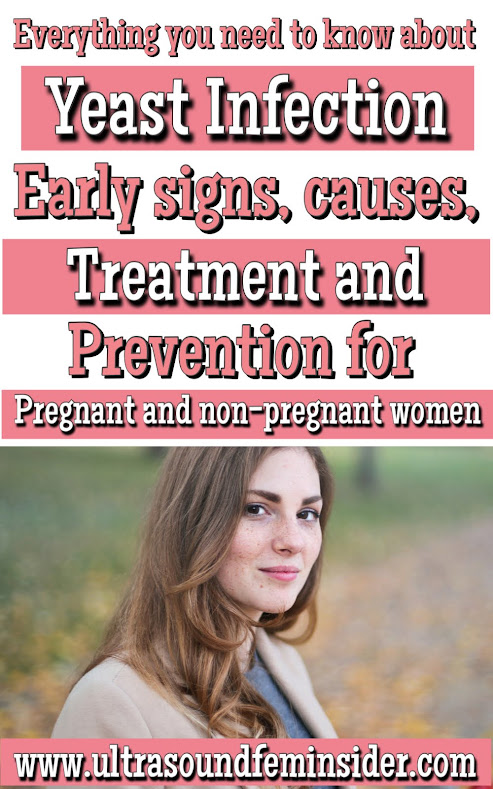Vaginal yeast infection is a frequent genital fungal illness. It produces vaginal discharge, discomfort, itching, and inflammation. It can affect both men and women. A yeast infection is caused by an overgrowth of a yeast species called Candida on certain parts of the body. Yeast infections of the vaginal area are also known as vaginal candidiasis or vulvovaginal candidiasis (VVC). It affects up to three out of every four females at some point in their lives. The causes, symptoms, and diagnosis of yeast infections, as well as treatment and home cures, will be discussed in this article. Ready? Let’s begin.
What are the early signs of a yeast infection?
- Yeast infections with discharge have a thick, white appearance, similar to cottage cheese.
- Itching, burning, or irritation of the vaginal or vulva tissue (the tissue that surrounds the vaginal opening).
- Pain or discomfort in the vaginal entrance or in the vaginal canal.
- Burning in the vaginal area during intercourse or urination.
- Watery Vaginal discharge.
- A rash.
Sometimes a more complicated yeast infection may occur with more severe symptoms. Four or more infections may arise in 1 year. Doctors refer to this as recurrent vulvovaginal candidiasis (RVVC). There may be severe redness, swelling, and itching, leading to skin fissures or sores with a complicated yeast infection.
Medical conditions that can cause a complicated yeast infection may include:
- Pregnancy.
- Unmanaged diabetes.
- Having a weakened immune system.
- The presence of an alternate Candida fungus, as opposed to Candida albicans.
In males, a yeast infection can affect the head of the penis. Symptoms include redness, irritation, and discharge. It can also affect the skin or the mouth.
When to seek medical attention for a yeast infection?
Contacting a doctor is the quickest way to get rid of a yeast infection. They are capable of making an accurate and quick diagnosis. They’ll provide you the best treatment for your illness. The majority of vaginal yeast infections are minor and do not cause discomfort. Some folks don’t show any signs or symptoms at all.
If you have symptoms like these, the Centers for Disease Control and Prevention (CDC) suggests seeing a doctor.
- Itching.
- Soreness.
- Pain.
- Discharge that is unusual.
- Whether the infection is difficult or not determines how it is treated. A complex yeast infection may have more symptoms or be more severe than a simple yeast infection. A person may, for example, feel vaginal or labial edema.
If a woman gets repeated infections or if the infections develop as a result of a compromised immune system, this is another symptom of a problem, please seek the attention of a doctor.
Treatment for non-pregnant women.
An uncomplicated yeast infection can be treated with either vaginal therapy or oral treatment. A brief course of vaginal medication is generally enough to treat a simple yeast infection.
One alternative is to use a prescription or over the counter (OTC) drug for a single treatment, such as:
- Butoconazole (Gynazole-1)
- Clotrimazole (Gyne-Lotrimin)
- Miconazole (Monistat 3)
- Terconazole (Terazol 3)
Some of these are available to buy online, including clotrimazole, Monistat 3, and terconazole.
Because these medications are oil-based, they can weaken latex condoms and diaphragms, potentially making them less reliable. Is highly recommended to stop sexual activity while treating a yeast infection. However, if you are planning not to, you can use nonlatex-based condoms instead to ensure a good protection.
Alternatively, a single dose of an oral antifungal such as fluconazole (Diflucan) can be utilized.
What happens if the infection is complicated?
- The use of long-course vaginal therapy or multidose oral formulations will be used in the case of a serious yeast infection.
- Medications for maintenance may be prescribed by a doctor. These treatments may be taken on a regular basis to prevent the illness from recurring.
- Treatment using a vaginal cream, ointment, pill, or suppository for 7–14 days is known as long-course vaginal therapy.
- Instead of vaginal therapy, a doctor may prescribe two to three doses of oral fluconazole.
If your symptoms are severe, your doctor may give topical steroids for a few days to help you feel better while the antifungal medicine works. It’s critical to confirm if the symptoms are caused by a yeast infection before utilizing antifungals. Overuse of antifungals can lead to yeast resistance, which means the treatments may no longer work when they are needed in the future.
If maintenance drugs are required, they should be started after one of the following treatment procedures has been completed. It could involve a 6-month course of oral fluconazole or a weekly course of vaginal clotrimazole.
If the person’s sexual partner is experiencing yeast symptoms, they should get therapy as well. Condoms or other barrier techniques are frequently recommended by medical practitioners.
Share the post to Pinterest.

Causes of a yeast infection.
The overgrowth of yeast on a body part is the main cause of a yeast infection. Candida albicans produces the most frequent yeast infections, however other Candida species can also cause an infection. It’s possible that they’ll require different treatment. In the vagina, balanced quantities of yeast and bacteria are usually present, but disruptions in this delicate equilibrium can lead to infection. Normally, Lactobacillus bacteria provide an environment that discourages yeast overgrowth, but if yeast takes over, signs of a yeast infection may appear.
Causes:
- The use of antibiotics, corticosteroids, or a combination of the two.
- Pregnancy (keep reading for detailed information about yeast during pregnancy)
- Hormonal contraceptives and contraceptive devices.
- Diabetes that is uncontrolled.
- Having a weakened immune system.
- A yeast infection can be caused by any activity that alters the normal vaginal flora, such as douching. In addition, a poor diet and a lack of sleep may raise the risk.
Is a yeast infection a Sexually transmitted diseases?
Although vaginal yeast infections are not sexually transmitted diseases (STIs), they can be spread through oral-genital contact or during intercourse.
A doctor will inquire about a person’s medical history, including any STIs or past yeast infections, when diagnosing a vaginal yeast infection. They may also perform a pelvic exam to look for symptoms of infection in the vulva, vagina, and cervix. To confirm the diagnosis, they may send a sample of vaginal discharge to a laboratory.
Diagnose.
If an illness does not go away or returns, a doctor will usually order laboratory tests. If significant amounts of yeast are present, a swab of vaginal discharge can be examined under a microscope. Treatment can begin once it is determined if the infection is simple or complicated.
Prevention.
While there is no surefire way to avoid getting a Candida infection, there are some things you may do to lower your chances of getting a vaginal yeast infection.
Susceptible woman should take the following precautions:
- Stay away from douching.
- Do not use deodorant, deodorant pads, or tampons in your vaginal area.
- Underwear made of cotton or other natural fibers should be worn.
- Dress comfortably in loose-fitting pants or skirts.
- Underwear should be washed at a high temperature.
- Pantyhose and tight undergarments should be avoided.
- Eat a balanced, nutritious diet.
- Wet clothing, such as bathing suits, should be changed as soon as possible.
- Hot pools and baths should be avoided.
Anyone who thinks they have signs of a yeast infection should see a doctor as soon as possible to get a proper diagnosis. Even if a person has previously experienced a yeast infection, they should seek medical advice. Other illnesses, such as bacterial vaginosis and some STIs, can mimic yeast infections and necessitate immediate treatment. If a person’s yeast infection does not cure up after a short course of medication or if they have frequent infections, they should see a doctor. This could be a case of a difficult yeast infection that necessitates a different approach.
What you need to know about Yeast Infections During Pregnancy and how to treat it?
Various over-the-counter antifungal vaginal creams or suppositories can be used to safely treat a yeast infection during pregnancy. However, it’s advisable to double-check with your doctor that your symptoms are caused by a yeast infection before beginning therapy.
Because hormone changes can affect the vaginal pH balance, yeast infections are more likely during pregnancy. The most common signs of a yeast infection are vaginal irritation and a white, thick discharge that resembles cottage cheese.
Specifically for pregnant woman you can safely try these over-the-counter medications.
- Clotrimazole (Mycelex, Lotrimin AF)
- Miconazole (Monistat 3)
- Terconazole
- Yeast infections can be also treated with other over-the-counter drugs such as creams, ointments, and suppositories.
These products are safe to use at any stage of pregnancy and do not cause birth abnormalities or other issues. Choose a seven-day formula for the greatest results. If you’re pregnant, oral medicine isn’t advised.
Some antifungals, such as fluconazole (Diflucan), should be avoided during pregnancy, especially during the first trimester. If you go to the doctor for a yeast infection and you’re extremely early in your pregnancy, make sure you tell them you’re expecting.
A topical therapy, such as a vaginal cream or suppository, is usually recommended by doctors. Fluconazole oral medication is not recommended during the first trimester, but it can be used subsequently.
When a woman is menstruation, might she acquire more yeast infections?
Changes in hormone levels can increase the likelihood of a yeast infection. As a result, some people may develop increasing symptoms or a yeast infection soon before their period begins.
A yeast infection generally clears up after a person’s period because blood has a higher pH and can help restore the vaginal pH equilibrium.
Can a yeast infection be caused by a urinary tract infection (UTI)?
Both yeast infections and urinary tract infections (UTIs) are frequent. When diagnosing a yeast infection, a doctor may obtain a urine sample to rule out a UTI.
Because of changes in hormone levels, UTIs and yeast infections are more likely during pregnancy. Antibiotics are used to treat urinary tract infections; However, they can alter the bacteria’s equilibrium. A yeast infection may be more likely as a result of this shift in the balance.
A yeast infection is only found in one gender.
This infection can affect both men and women. Symptoms of a penis include redness, itching, and discomfort at the head of the penis. When they urinate, there may be a discharge as well.
Related articles about women health.
Pelvic pain in women. Role of ultrasound diagnosing pelvic pain.
Dysmenorrhea. Causes, symptoms and remedies.
All about Polycystic ovarian syndrome or PCOS.
Ovaries, hormonal cycles and common cysts.
Zadi, xo
Disclaimer: The medical information on this post is for educational and entertainment use only. Under no circumstances, this information is to replace your doctor’s advice or to treat any disease. For proper care, always visit your doctor.










[…] Everything About Yeast Infection. […]